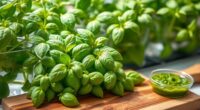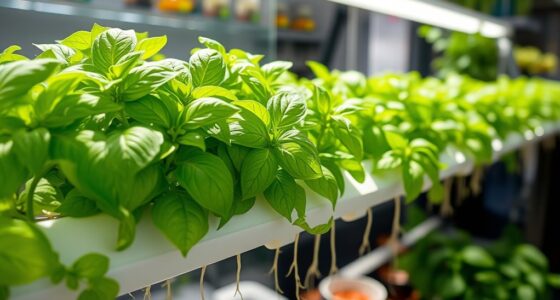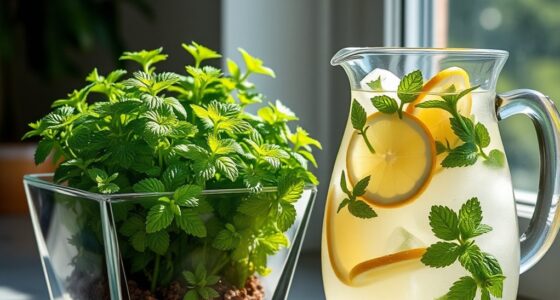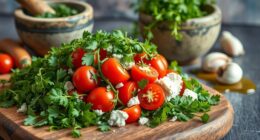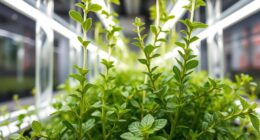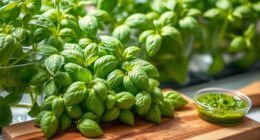To make farm-to-dessert indoor garden fruit tarts, start by selecting seasonal fruits like strawberries, blueberries, or apples, and grow them in pots near a sunny window or under grow lights. Water your plants carefully—check moisture levels regularly—and harvest ripe fruits at their peak for the best flavor. Controlling light, temperature, and watering guarantees vibrant, tasty ingredients. Keep exploring to discover how to perfect your indoor gardening and create delicious, fresh fruit tarts.
Key Takeaways
- Grow seasonal, ripe fruits indoors by controlling light, temperature, and watering for optimal flavor in homemade tarts.
- Use proper watering techniques, checking soil moisture before watering thoroughly to prevent root rot.
- Harvest fruits at peak ripeness to ensure the best flavor for your fruit tarts.
- Position plants near natural or grow lights to promote healthy growth and sweet, flavorful fruit.
- Combine fresh, home-grown fruits with seasonal variety for vibrant, farm-to-dessert indoor fruit tarts.
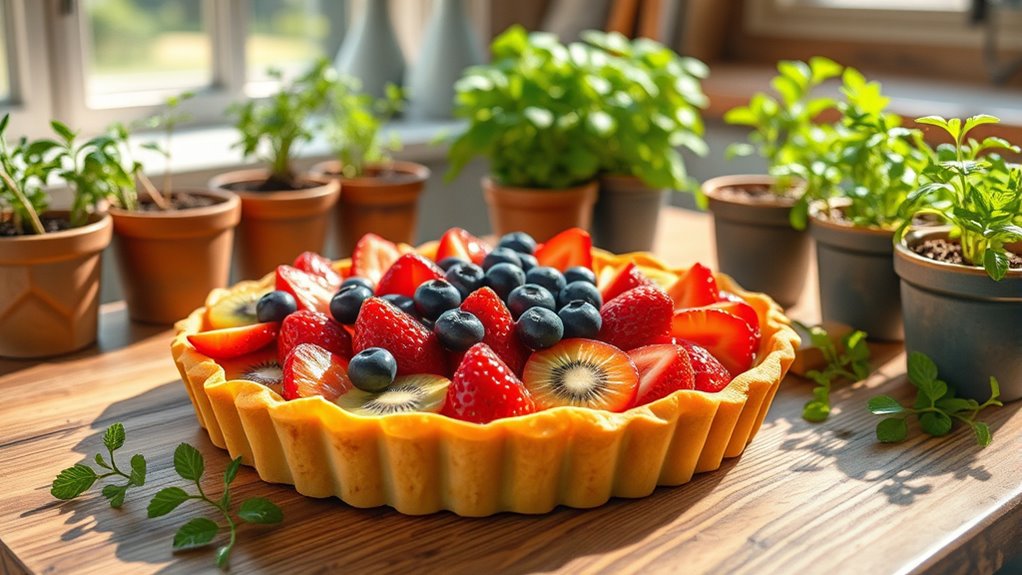
Creating your own indoor garden fruit tarts combines the freshness of homegrown produce with the indulgence of a delicious dessert. When you start cultivating fruit plants indoors, you gain control over their health and flavor, which directly impacts your tart’s quality. One of the most important aspects of maintaining your indoor garden is mastering watering techniques. Unlike outdoor gardening, where rain and soil moisture balance naturally, indoor plants rely solely on you. You want to water consistently but avoid overwatering, which can lead to root rot. Use a moisture meter or touch the soil surface to check for dryness before watering. Water thoroughly until excess drains out, ensuring roots receive enough moisture without becoming waterlogged. Proper watering promotes healthy growth, vibrant fruit, and better flavor for your tarts.
As your plants develop, you should also think about seasonal flavor combinations. Growing a variety of fruits that ripen at different times allows you to craft tarts that reflect the seasons. For example, in spring, strawberries and rhubarb are perfect choices—they’re fresh, tangy, and complement each other well. Summer offers an abundance of berries like blueberries, blackberries, and raspberries, which add vibrant color and sweetness. In fall, consider apple or pear varieties for a cozy, warm flavor, while winter might bring citrus fruits like oranges and grapefruits, which add a bright, invigorating note to your desserts. By selecting fruits according to their seasonal availability, you maximize flavor and ensure your tarts are always at their peak. Plus, growing seasonal fruits keeps your indoor garden dynamic and exciting, encouraging you to experiment with different flavor combinations throughout the year.
To make the most of your indoor fruit garden, pay attention to light and temperature as well. Fruits thrive with ample sunlight, so position your plants near a south-facing window or use grow lights if natural light is limited. Consistent temperature control helps fruits develop fully, enhancing their sweetness and texture. When it’s time to harvest, pick your fruits at their peak ripeness for the best flavor. Use these freshly picked fruits directly in your tart recipes, or store them properly to preserve their flavor for later. Combining your knowledge of watering techniques with seasonal flavor combinations elevates your homemade fruit tarts from simple desserts to a true farm-to-dessert experience. Every step, from nurturing your plants to selecting the perfect fruits, adds a personal touch that makes each tart a celebration of your indoor gardening efforts.
Frequently Asked Questions
What Are the Best Lighting Conditions for Indoor Fruit Gardens?
You should aim for bright, indirect light to grow healthy indoor fruit gardens. LED lighting is an excellent choice because it provides consistent, energy-efficient illumination. Keep the light duration around 12-16 hours daily, mimicking natural sunlight. Adjust the LED lights to guarantee your plants get enough light without overheating. Consistent light conditions help your indoor garden thrive and produce delicious, ripe fruits for your fruit tarts.
How Often Should Indoor Garden Plants Be Watered?
You’re right to ask how often to water your indoor garden plants. Think of your watering schedule as walking a tightrope—you want to keep soil moisture just right. Check soil moisture daily; water when the top inch feels dry. Overwatering can drown roots, while underwatering stresses plants. Adjust based on plant type, humidity, and pot size, and you’ll keep your indoor garden thriving without a hitch.
Which Indoor Fruit Plants Are Easiest for Beginners?
If you’re new to indoor gardening, start with easy fruit tree varieties like dwarf citrus, figs, or strawberries. Choose a container with good drainage and appropriate size to support healthy growth. These varieties are resilient and forgiving, making them perfect for beginners. Focus on proper container selection, ensuring your plants get enough light and consistent watering. With patience, you’ll enjoy fresh, homegrown fruit right in your indoor space.
How Do I Prevent Pests in My Indoor Garden?
To prevent pests in your indoor garden, focus on pest prevention by maintaining cleanliness and proper airflow around your plants. You should also use organic controls like neem oil or insecticidal soap, which are safe and effective. Regularly inspect your plants for early signs of pests, and act swiftly to remove any affected leaves. Keeping your garden healthy and balanced helps keep pests at bay naturally.
What Are Some Common Nutrient Deficiencies in Indoor Plants?
Imagine your indoor garden whispering for a little extra care. You might notice yellowing leaves or stunted growth—signs of soil nutrients running low. Common nutrient deficiencies include nitrogen, causing pale leaves; phosphorus, leading to poor flowering; and potassium, which can cause leaf edges to brown. Recognizing deficiency symptoms helps you nourish your plants properly, ensuring vibrant, healthy growth and a thriving indoor oasis.
Conclusion
As you step back to admire your indoor garden fruit tart, it’s like watching a tiny orchard bloom on your countertop. Just as a gardener tends to each delicate bloom, you’ve nurtured vibrant strawberries and plump blueberries right at home. Studies show that growing your own produce boosts both flavor and satisfaction. So, keep cultivating your culinary oasis—because, in this miniature paradise, every bite is a reminder that beauty and nourishment thrive when you nurture them.

